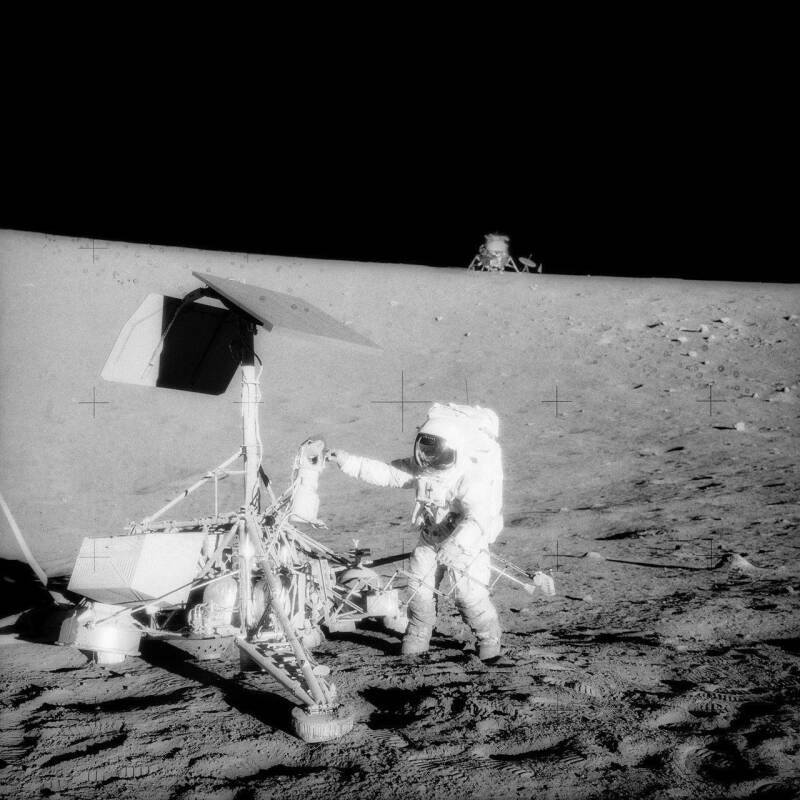Lunar dust—unlike the harmless dust we find on Earth—poses a serious challenge for future Moon missions. Known as regolith, these microscopic particles are sharp, abrasive, and cling stubbornly to surfaces due to the Moon’s lack of atmosphere. Not only can lunar dust damage critical equipment, but it also poses potential respiratory hazards to astronauts.

This unusual photograph, taken during the second Apollo 12 extravehicular activity (EVA), shows two U.S. spacecraft on the surface of the Moon. The Apollo 12 Lunar Module (LM) is in the background. The unmanned Surveyor 3 spacecraft is in the foreground. Credit:NASA
To tackle this issue, a team of NASA-funded researchers at the University of Central Florida (UCF) is developing a revolutionary nanocoating that could passively repel lunar dust, helping protect spacecraft, rovers, and astronaut gear, and ultimately extending the duration and success of lunar missions.
“The dust particles on the moon are very sharp, very sticky, and very toxic,” said Lei Zhai, director of UCF’s NanoScience Technology Center and project lead. “Our goal is to fully understand how these particles interact with surfaces in a simulated lunar environment, so we can engineer coatings that prevent dust from sticking in the first place.”
Unlike Earth, where weather and erosion smooth surfaces over time, lunar dust remains jagged and glass-like. Simply brushing or wiping it off risks scratching delicate sensors or equipment. UCF’s team is therefore pursuing passive dust mitigation techniques—coatings designed to make dust fall away naturally when exposed to forces such as solar radiation or vibrations, rather than active methods like electric fields or mechanical cleaning.
To replicate lunar conditions, researchers use vacuum chambers filled with simulated regolith while excluding Earth’s atmospheric effects. They also introduce irradiation sources to mimic intense solar radiation on the Moon. Advanced tools such as atomic force microscopes (AFM) allow the team to study how individual dust particles adhere to surfaces at the nanoscale.
“Repeated experimentation lets us fine-tune surface structure, hardness, and conductivity,” Zhai explained. “With this data, we can design specific coatings optimized for dust resistance.”
Dr. Adrienne “Addie” Dove, professor of physics and department chair at UCF, oversees the vacuum chamber experiments and brings extensive expertise on lunar dust behavior. “Lunar dust is one of the biggest challenges for long-duration stays on the Moon,” Dove noted. “This project is exciting because it focuses on changing surface properties so that dust simply doesn’t stick as much.”
Dr. Laurene Tetard, a physics professor and AFM expert, is examining the fundamental forces between dust particles and the engineered coatings. “We’re linking nanoscience with space exploration in a new way,” Tetard said. “The insights we gain will help optimize these surfaces and advance future space technologies.”
Additionally, Dr. Tarek Elgohary, associate professor of mechanical and aerospace engineering, is developing computer simulations that model dust behavior and interactions with various surfaces. These models are cross-checked with experimental data to refine the nanocoating designs.
The team believes this research could lead to breakthroughs not only for NASA’s Artemis missions but also for other space industries requiring dust-resistant technologies. Boeing and other aerospace partners are closely monitoring advancements in passive dust mitigation, which could safeguard everything from cameras to power systems on future lunar habitats.
“Dust gets everywhere—like sand at the beach, but much worse,” Dove said. “Our goal is to design materials where dust doesn’t just stick, so astronauts can focus on exploration rather than constant cleaning.”


Add comment
Comments